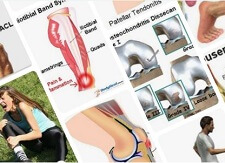- Home
- Knee Pain Diagnosis
- Swollen Knee
- Swelling in Front of Knee
Swelling In Front Of Knee
Written By: Chloe Wilson, BSc(Hons) Physiotherapy
Reviewed by: KPE Medical Review Board
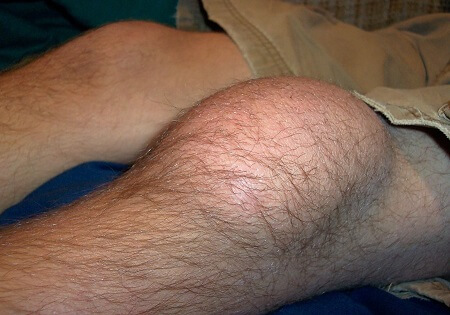
Swelling in front of the knee is a common problem which may cause pain and stiffness.
There are lots of possible causes of swelling or a lump in front of the knee but usually it’s nothing too serious.
Front knee swelling is often caused by inflammation, excess fluid, tearing or damage to one of the soft tissues in or around the knee or kneecap, but may also be a sign of an underlying medical condition.
There may be a bulge or pocket of swelling, a lump in front of the knee or generalised swelling around the knee. The swelling may fluctuate or be fairly consistent, depending on what you do and the underlying cause.
What Causes Front Knee Swelling?
There are a number of different things that can cause swelling in front of the knee and each will present slightly differently.
We will start by looking at the four most common causes of front knee swelling and a swollen kneecap and the causes and symptoms of each one. Then we will go on to look at the some of the other possible causes of swelling in front of the knee and how to treat them. If you are more bothered by pain than swelling, check out our front knee pain article.
1. Prepatellar Bursitis
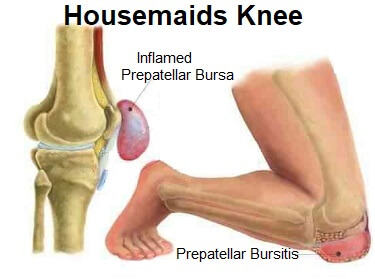
The most common cause of swelling in front of the knee is prepatellar bursitis, also known as Housemaids Knee.
The prepatellar bursa is a small, fluid-filled sac that sits in front of the kneecap, just underneath the skin. It helps to provide some protection and cushioning to the kneecap.
But if there is excessive friction or pressure through the prepatellar bursa then it can start to swell. Excess fluid around the knee cap forms in the bursa and it starts to balloon, usually forming a defined pocket of swelling, similar to a squashy orange.
Swelling in front of the knee from prepatellar bursitis is usually caused by prolonged or repetitive kneeling, hence the name housemaid’s knee, but is now more commonly seen in tradesmen and gardeners. It may also develop following a hard blow to the knee e.g. a fall or with certain medical conditions e.g. inflammatory arthritis.
In most cases, a swollen kneecap from prepatellar bursitis can be treated at home and will settle down within a few weeks, but if the swelling in front of the knee persists, the bursa may need to be drained or surgically removed.
There are a few other bursa that can also become inflamed around the front of the knee leading to:
- Suprapatellar Bursitis: causing swelling above the knee
- Infrapatellar Bursitis: causing swelling below the knee
- Pes Anserine Bursitis: causing swelling on the inner side of the knee
You can find out more about the causes, symptoms, diagnosis and treatment of swelling in front of the knee in the Prepatellar Bursitis section.
2. Gout Knee
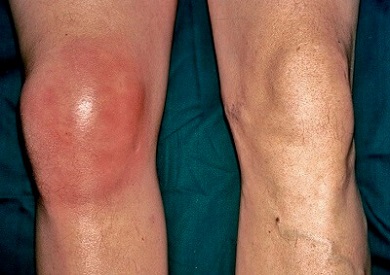
If you have redness and swelling in front of the knee and the area feels hot and painful, chances are it’s gout knee.
Gout knee is a type of inflammatory arthritis that causes the knee to swell rapidly and can be extremely painful.
Swelling in front of the knee from gout is usually accompanied by redness and warmth and symptoms often come on very quickly at night. There may be profuse front knee swelling or small, firm lumps may form underneath the skin, known as tophi.
Front knee swelling from gout is caused by a build-up of uric acid which forms crystals in the knee joint. You are more likely to develop gout knee as you get older, particularly if you are obese, have a purine-rich diet, certain medical conditions or a family history of gout.
Swelling in front of the knee from gout is usually treated with a combination of medication, lifestyle changes, ice and rest. In most cases, gout settles down within a few weeks but repeated incidences are common with around 60% of people having a repeat episode within a year. But there are simple things you can do to reduce the risk of a gout knee attack.
Find out all about front knee swelling from gout including the causes, symptoms, diagnosis, treatment and prevention options in the gout knee section.
3. Patella Injuries
Kneecap swelling can also develop in response to patella injuries.
It usually takes a great deal of force to damage the kneecap such as a heavy fall or RTA which can result in:
- Dislocated Patella: where the kneecap is forced sideways out of its usual position
- Patella Fracture: where the kneecap breaks into two or more pieces
Both injuries are fairly rare as there are strong ligaments holding the kneecap in place and it takes a great deal of force to break the bone.
Patella injuries are usually accompanied by profuse swelling in front of the knee, and if the kneecap dislocates, there may be a hard bulge to the side of the knee where the bone is out of place. Kneecap injuries are usually extremely painful and may make it difficult to walk. Patella injuries require immediate medical attention.
You can find out lots more about how kneecap injuries cause front knee swelling including the symptoms, diagnosis and treatment options in the Kneecap Injuries section.
4. Knee Arthritis
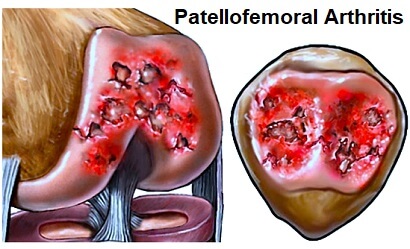
A common cause of swelling on front of the knee in people over the age of 60 is knee arthritis.
There are lots of different types of knee arthritis but the most common is osteoarthritis which causes wear and tear and degeneration of the knee bones and cartilage and knee bone spurs.
Front knee swelling from arthritis tends to come on gradually and often fluctuates. There may be no swelling at all at times but if you overdo things, twist the knee awkwardly or it gets knocked or damaged, then the irritation causes the joint to produce excess synovial fluid in an attempt to protect and heal itself. Front knee swelling from arthritis can occur in two different places in the knee:
- Patellofemoral Arthritis: affects the patella resulting in kneecap swelling
- Tibiofemoral Arthritis: affects part or all of the knee joint resulting in either localised or general knee swelling
Swelling in front of the knee that is associated with arthritis is often accompanied by knee stiffness, particularly when you first get up in the morning or after sitting for a while. The stiffness eases off as you move around.
There are lots of things you can do to help reduce kneecap swelling from arthritis including exercises, wearing a knee brace, natural remedies and supplements, acupuncture, lifestyle changes and medications. However in some cases, surgery may be recommended, most typically an arthroscopy or knee replacement.
You can find out more about front knee swelling from arthritis and the causes, symptoms, diagnosis and treatment options in the Knee Arthritis section.
Other Possible Causes Of Front Knee Swelling
There are a number of other things that can cause swelling in front of the knee, but they tend to be less common or result in more generalised knee swelling.
1. Runners Knee
Runners Knee, aka patellofemoral pain syndrome, can cause mild kneecap swelling.
Runners knee is caused by excessive friction on the back of the kneecap due a problem with how the patella moves.
This results in anterior knee pain, particularly when coming down stairs or walking downhill, when you first get up or after being on your feet for long periods.
Runners Knee is just as likely to affect office workers as runners and can take anything from six weeks to six months to subside with correct treatment. Find Out More >
2. Chondromalacia Patella
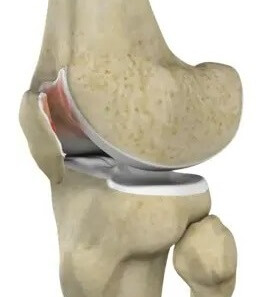
Chondromalacia patella is the most common cause of pain and mild swelling in front of the knee in young, healthy, sporty individuals.
Softening and irritation of the cartilage on the back of the kneecap causes front knee pain, mild kneecap swelling and clicking/grinding sensations when bending the knee.
There are lots of treatment options for front knee swelling from chondromalacia patella including exercises, knee straps, orthotics and taping. Find Out More >
3. Osgood Schlatters
If you have a hard lump in front of the knee, about 2cm below the kneecap, you probably have Osgood Schlatters disease. It is most commonly seen in adolescents who play lots of sports involving kicking, running and jumping, or after a sudden growth spurt. Quads muscle tightness pulls on the front of the shin bone resulting in inflammation and a hard, bony lump at the front of the knee.
With Osgood Schlatter disease, pain comes and goes with activity and treatment involves a combination of rest, knee straps, medication and exercises. Find Out More >
4. Patellar Tendonitis
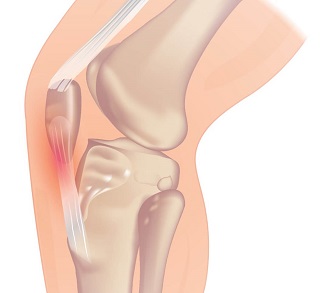
Patellar tendonitis causes pain and swelling in front of the knee, just below the kneecap.
Inflammation and damage to the patella tendon from repetitive sporting activities e.g. jumping and kicking, or sudden increases in training, causes tearing in the patellar tendon. This leads to thickening of the tendon and a firm bump below the kneecap which is tender to touch.
Symptoms of patellar tendonitis typically get progressively worse over time, increasing in intensity and frequency. Treatment for swelling in front of the knee from patellar tendonitis involves a combination of ice, rest, knee straps, exercises and occasionally surgery. Find Out More >
5. Meniscus Tear
Swelling in front of the knee can also be a sign of a meniscus tear. The meniscus is a thick layer of cartilage that lines the knee joint. Meniscus tears can occur from one-off injuries e.g. twisting awkwardly on a fixed foot, or gradually from repetitive wear and tear. Front knee swelling from a meniscus tear usually builds up over 48 hours following an injury. The amount of swelling will depend on the severity and location of the tear and may not be confined to the front of the knee.
Meniscus tear are often associated with knee locking, where the knee gets intermittently stuck as you try to move it. They are often slow to heal so it is important to start treatment as soon as possible. Find Out More >
6. Ligament Sprain
Overstretching or tearing of one of the knee ligaments, known as a knee sprain, can lead to front of knee swelling. Ligaments are strong, thick bands of tissue that connect the knee bones and are the key stabilisers of the knee. If one of the knee ligaments gets overstretched, usually from awkward twisting or a force through the knee, then some or all of the ligament fibres get torn.
The more fibres that are torn, the more the knee is likely to swell. Swelling from a ligament sprain can occur anywhere in the knee depending on which ligament is torn and the severity of the injury.The initial goal of treatment is to reduce the knee swelling and pain so that you can then begin a rehab program to regain strength and stability in the knee. Find Out More >
7. Synovial Sarcoma
A rare, but serious cause of front knee swelling is a synovial sarcoma, a malignant growth that forms a cancerous lump in front of the knee. Synovial sarcomas are rare and usually affect young adults. A synovial sarcoma lump on the front of the knee is usually larger than 5cm, gets progressively bigger and is often painful. Swift diagnosis and treatment is essential.
8. Infection
Swelling in front of the knee is sometimes due to an infection in the joint e.g. septic arthritis. Excess fluid and inflammation from the infection leads to knee swelling, redness and warmth and can be quite painful. Front knee swelling from a knee infection is usually treated with antibiotics.
Front Knee Swelling Treatment
The best treatment for swelling in front of the knee will depend on the underlying cause of the swelling, but will aim initially to reduce the excess fluid in the knee. Treatment for front knee swelling will usually involve a combination of:
- PRICE: protect, rest, ice, compress & elevate
- Medications: anti-inflammatory and pain relief medication
- Exercises: strengthening and stretching exercises to restore knee strength, stability and mobility
- Injections: corticosteroid knee injections
- Aspiration: Fluid is drained from the knee with a needle
- Knee Straps Or Braces: to support or off-load parts of the knee
You can find out loads more about how to reduce swelling in front of the knee and get the best results in the swollen knee treatment section.
Swelling In Front Of Knee Summary
Front knee swelling is a common problem with a number of possible causes.
The most common cause of swelling in front of the knee is prepatellar bursitis aka housemaids knee where a pocket of fluid around the kneecap develops.
Front knee swelling associated with redness, heat and pain is usually due to gout knee or an infection.
Sudden swelling in front of the knee usually occurs after an injury such as a ligament sprain, meniscus tear or kneecap injury.
A lump on the front of the knee may be from a sarcoma (firm), tendonitis (tender), bone spurs (hard) or Osgood Schlatters (hard lump below knee).
Generalised front knee swelling that may extend to other parts of the knee may be caused by arthritis, meniscus tear, ligaments sprain or an infection.
Treatment for swelling in front of the knee normally involves a combination of PRICE, medications, exercises, injections and aspiration – occasionally surgery may be recommended.
You might also be interested in the following articles:
- Swelling Above The Knee
- Swelling Behind The Knee
- Swelling Below The Knee
- Swelling On Side Of Knee
- Front Knee Pain
- Side Knee Pain
- Pain Behind The Knee
- Burning Knee Pain
- Knee Pain On Stairs
- Knee Pain & Popping
Page Last Updated: 23/04/23
Next Review Due: 23/04/25

